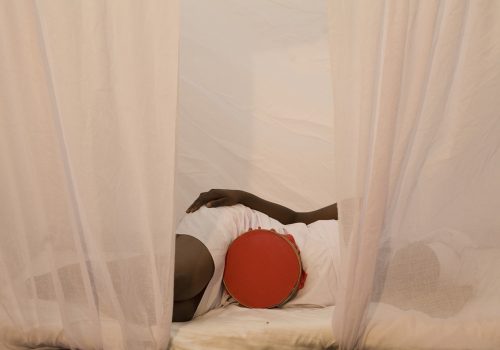The author and former Minister of Culture and Tourism of Mali, Aminata Traoré wrote, “We, the peoples of Africa, colonised in the past and re-colonised today in favour of globalised capitalism, do not cease asking ourselves: what has become of us?”
Does the eleventh Bamako biennial give an answer to the question? Its title, Afrotopia, taken from an essay by the Senegalese economist and writer Felwine Sarr, is a neologism of his own invention, meaning “a utopia whose task is to push the vast spaces of the possible into the African reality and fertilise them”.
I ask myself how to question the dominant market discourse and the exhibition’s traditional western manner? Have some artists who have already been shown in Europe really been chosen for the African audience? Who sets the standards? At the moment it’s the western market as it’s the only one that is buying. Is it really utopian to think that the exhibited works will be bought by African collectors and institutions. I’ve always wished that this would be the case. Rethinking the challenge is a fundamental idea. In my search, I haven’t seen an installation that draws in-depth inspiration from the continent’s particularities. It’s a pity. We’ve seen at Art Paris and the AKA at the Carreau du Temple, that the African artists are unfortunately presented as a fad, and I’m wary of fads that are short-lived most of the time. Especially since for this eleventh Bamako biennial, all the prints in the IN Festival were made in Paris, the framing, too. Is this normal? The photographers from the OFF, who’ve hardly been helped at all, made their own prints in Bamako or other African cities, and most of the framing was done on-site. If I understand it well, the economy is still Franco-French, in a repudiation of local expertise.
So here are the works that attracted my attention at the eleventh edition of the Rencontres de Bamako.
IN Festival
At the National Museum
- Fotolala King Massassy – Anarchie productive (Côte d’Ivoire-Mali)
King, with his images made in the studio in the style of Epinal, depicts specifically Malian daily life, often wrongly considered “anarchic” whereas in reality it is a source of “productive” energy.
- Sarah Waiswa – Stranger in Familiar Land (Ouganda-Kenya)
I was charmed to see these images again, all the more so since East Africa is often under-represented at the Bamako biennial, but very surprised because Sarah was shown previously at the Rencontres d’Arles, where she received the Découverte prize in 2016. Mali is the country of Salif Keïta, who set up a foundation for albinos, still persecuted a little throughout Africa (especially in Tanzania and Uganda). Sara Waiswa idealises albinism, but why is she being shown again after Arles, at the Bamako biennial? Is it as a tribute to Salif Keïta? An opportunity for Africans to see this work?
- Joana Choumali (Côte d’Ivoire), with her series ça va aller illustrates the post-attack trauma of Grand Bassam. Her talent is in having embroidered with a needle and thread the indelible, violent tattooing of trauma on postcard images
- Alain Polo – Série blanche (RDC-France)
Alain Polo continues his artistic research on his body, work which I had previously noticed in 2010, in the SudParis collective exhibition at the Revue Noire. In Bamako, he uses white as a colour, the technique mattering little.
- Delio Jasse – The lost chapter (Angola)
Was Délio Jasse inspired by Miquel Gomesqui’s film Tabou to retrace the past romance of an old lady and her lover in Angola, then a Portuguese colony? The film was shot in the places of Portuguese colonisation, while Délio Jasse shows photos of the colonist families in Angola, in the lost “paradise” from the Portuguese past. By superimposing the stamps from the family’s administrative archive he systematises an African ghost.
At the Institut Français
The archives are also used as the subject matter for Gabrielle Mangiou’s photographs, (L’Autre, extract from the film “Escale Argentique”, La Réunion) and by Amalia Ramankirahina (Madagascar) Portraits de famille, being shown at the Institut Français in a group exhibition entitled La Part de l’Autre (curated by Nathalie Gonthier. The two artists re-appropriate the past by adding an intimate and contemporary imagination to old documents. It’s the opposite of Délio Jasse, who is left with the denunciation of the colonial past.
OFF Festival
Forty-seven exhibition venues throughout the city and open to all Bamakoans, a tour de force made possible thanks to the goodwill and energy of the photographers
Some symbolic locations, such as the El Hilal cinema, where Souleymane Cissé’s first film was shown. Inside a collaborative project by François-Xavier Gbré, Yo-Yo Gonthier, Nii Obodai and Kal Touré, with the support of the Cécile Fakhoury Gallery; outside photographs by Nathalie Mazéas.
At “La Gare” Seiba Keita and Bandjougou Kouvaté, a group of conceptual images. At Santoro, “Elles en œuvre”: Oumou Traoré, Oumaou Diarra and Kany Sissoko. At the Soleil d’Afrique centre, Jacques M. Q. Do Kokou presents le Chemin du vaudoun hagodrafo à Ouida. . A l’Acerca Afrotopia, a group exhibition. A special mention of Igo Diarra’s Médina Gallery, Bamako’s artistic creative space for the past ten years.
Françoise Huguier
Françoise Huguier is a French photographer who lives and works in Paris. From fashion to reportage, from the snapshot to the staged, she keeps the same eye for graphics that’s never without humour. Impassioned by journeys and encounters with countries and their inhabitants, she brought us to Africa with Sur les traces de l’Afrique fantôme in 1990, followed by Secrètes in which she was able to show the privacy of African women. A special relationship connects her to the African continent
Eleventh Edition of the Rencontres de Bamako
From 2nd December 2017 to 3ist January 2018
Various locations
Bamako, Mali
















